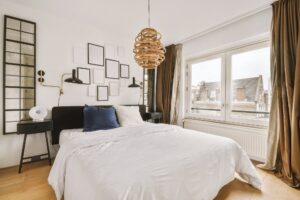An age-old Chinese technique called feng shui aims to bring balance and harmony into the surrounding space. The Chinese term “Feng Shui” means “wind and water” and refers to the theory that the way things are arranged in a space can have an impact on the flow of energy, or “chi.”. Creating an environment that encourages positive energy flow can enhance one’s health, wealth, and general well-being. This is the aim of Feng Shui.
Key Takeaways
- Feng Shui is the ancient Chinese practice of arranging your environment to create balance and harmony.
- A balanced and harmonious layout can be achieved by arranging furniture and decor in a way that allows for easy flow of energy.
- Choosing the right colors and materials, such as natural fabrics and calming colors, can enhance the positive energy in a space.
- Incorporating natural elements like plants, water features, and natural light can bring a sense of tranquility and balance to a room.
- Decluttering and organizing your space is essential for allowing positive energy to flow freely and create a harmonious environment.
There are a few main Feng Shui principles that influence how a space is arranged. The Bagua is a map that represents nine distinct areas, each of which represents a different facet of life, such as relationships, career, and wealth. It is one of the most significant ideas. One can make changes to encourage harmony and balance in every aspect of life by comprehending the Bagua and how it pertains to a space. The five elements—wood, fire, earth, metal, and water—and their interactions to create a harmonious environment are also important concepts in Feng Shui.
These components can be used to create a supportive and balanced energy flow in a room. Recognizing how all elements of a space are related to each other and how they can affect the flow of energy within it is fundamental to grasping the fundamentals of Feng Shui. By using these ideas, one can design an area that uplifts & supports different facets of life, resulting in a setting that is more balanced and harmonious. As it directly affects the flow of energy within a space, designing a layout that is harmonious and balanced is crucial to Feng Shui. Putting the major furniture, like the bed or desk, in a position that gives them a clear view of the door and also gives them a sense of security and support is known as “command position,” & it’s a crucial component of Feng Shui layout.
There is a belief that this position fosters stability and control, both of which are beneficial to an individual’s overall health. Ensuring that energy flows freely and smoothly throughout the room is a key component of Feng Shui layout design. This can be accomplished by placing the furniture in a way that makes it simple to move around and enter every part of the space. To allow for the unhindered flow of energy, it’s also critical to keep spaces clutter-free and clear of obstructions. It is crucial to take into account the purpose of every area in a space and how it connects to the Bagua when designing a balanced and harmonic layout.
One can design a space that supports and enhances different facets of life by lining up the layout with the corresponding areas of the Bagua. To create a supportive and harmonious environment, careful consideration of furniture placement, energy flow, & alignment with the Bagua are all important aspects of designing a balanced & harmonious layout in Feng Shui. According to Feng Shui, a harmonious and well-balanced environment is largely dependent on the colors and materials used. Every hue has a distinct energy that can affect how a room feels overall and is connected to particular elements. For instance, the fire element is linked to warm hues like red, orange, & yellow, which can infuse a room with warmth, passion, and vitality.
Conversely, cool hues like purple, green, and blue are connected to the water element & can promote peace, quiet, & relaxation. The unique requirements of every area in a space should be taken into account when selecting colors in Feng Shui, as well as how various colors can support those needs. For instance, it could be advantageous to use soothing colors like gentle blues or greens in a bedroom where rest and relaxation are priorities. In a work environment where efficiency and concentration are crucial, vibrant hues like orange or red might be more appropriate. Apart from hues, selecting materials in Feng Shui is also essential for establishing a peaceful atmosphere. Every material has a different energy and set of characteristics that can affect how a space feels overall.
In Feng Shui, for instance, natural materials like wood, bamboo, & stone are frequently preferred due to their nurturing & grounding properties. These elements can foster a supportive and well-balanced atmosphere and foster a sense of connectedness to nature in a given area. Ultimately, selecting the appropriate materials and colors for a space requires careful assessment of the unique requirements of every area and how various materials and colors can support those requirements. A harmonious and well-balanced atmosphere that fosters wellbeing can be created by matching materials and colors to the intended energy of each space. A vital component of Feng Shui is the incorporation of natural elements, which can contribute to the harmony and balance of a space.
Natural materials, plants, and water features all have their own special energy that can enhance a room’s overall atmosphere. For instance, it’s said that plants not only purify the air & enhance a feeling of wellbeing, but also bring life, growth, and abundance to a space. Because they can instill a sense of tranquility, abundance, and prosperity in a space, water features like fountains and aquariums are also highly valued in Feng Shui. Positive energy flow and a calming atmosphere can be fostered by the soft sound of running water.
Natural materials like stone, bamboo, or wood can also help establish a space’s grounding and stability while also fostering a sense of connection to the natural world. When incorporating natural elements into a space, Feng Shui requires careful consideration of the unique requirements of each area & how various elements can support those needs. A harmonious & well-balanced environment that fosters well-being can be created by coordinating natural elements with each area’s desired energy. Organizing and decluttering are essential Feng Shui concepts because they have a direct effect on the energy flow in a room.
Clutter can produce negative or stagnant energy in a space by obstructing the flow of energy, or “chi.”. A room can be made open and free-flowing to encourage the flow of positive energy by decluttering and organizing it. To promote the free flow of energy throughout a space, it is crucial to maintain clear pathways according to Feng Shui. Eliminating extraneous items and arranging furniture to facilitate effortless movement & access to all sections of the space can help attain this goal.
Also, it’s critical to maintain clutter-free surfaces to promote the free flow of energy. Creating a positive energy flow in Feng Shui also involves organizing. A sense of harmony and order can be established in a space by carefully & purposefully arranging the objects. This can entail putting items in storage to keep them hidden or arranging things to create symmetry and balance.
Encouraging positive energy flow throughout a space is the general goal of Feng Shui decluttering and organizing. This is done by making the environment open and free-flowing. An environment that promotes harmony and balance and fosters well-being can be made by purposefully arranging objects and maintaining clear paths. Improving the energy of every space is crucial to Feng Shui since it can contribute to the creation of a peaceful & encouraging environment. Based on its intended use, every room in a space has different energy requirements. By being aware of these needs, one can make modifications to improve the energy flow in each room.
In Feng Shui, it’s crucial to take into account the unique requirements of every room in a space and the ways in which various components, including color, furniture arrangement, & natural elements, can support those needs. For instance, using relaxing colors like soft blues or greens in a bedroom where rest & relaxation are priorities may be helpful. A strong headboard and commanding position for the bed can also provide a sense of stability and security. Energizing colors like orange or red may be more appropriate in an office or workspace where focus and productivity are crucial.
Also, adding organic components to the room, like plants or water features, can promote a feeling of abundance & life. In general, improving the energy of each room through Feng Shui entails carefully analyzing the unique requirements of every section of the room and the ways in which various components can serve those requirements. One can create a harmonious & balanced environment that fosters well-being by coordinating colors, furniture placement, natural elements, and other elements with the intended energy of each room.
In Feng Shui, preserving harmony and balance over time is a continuous process that calls for constant maintenance & corrections. The energy requirements in a place vary with life circumstances, so it’s critical to make frequent modifications to make sure the setting still promotes wellbeing. Long-term maintenance of harmony and balance can be achieved, for example, by routinely evaluating the energy flow in a space and making necessary modifications.
To improve positive energy flow, this can entail clearing out clutter, rearrangement of furniture, or addition of new components like plants or water features. It’s also critical to periodically evaluate the potential effects of life transitions on the energy in a space. For instance, alterations to certain areas within a space may be necessary to ensure that they continue to support changes in relationships or career. All things considered, long-term Feng Shui maintenance of harmony & balance entails routinely evaluating the energy flow in a room and making modifications as necessary to guarantee that the setting still promotes wellbeing.
One can create an atmosphere that fosters harmony and balance for years to come by remaining aware of the shifting needs within a space.
Looking to create a harmonious and balanced living space? Check out our article on “Feng Shui Your Home: Tips for Harmonious Design” for expert advice on creating a peaceful and inviting atmosphere. And if you’re getting ready to decorate for the holidays, be sure to read our article on “7 Ways to Decorate for the Holidays” for some festive inspiration. Whether you’re looking to improve your home’s energy flow or simply want to create a cozy and welcoming environment, these articles offer valuable insights for creating a space that feels just right.
FAQs
What is Feng Shui?
Feng Shui is a traditional Chinese practice that involves arranging the environment to create harmony and balance. It is based on the idea that the arrangement of objects and spaces can affect the flow of energy, or “chi,” and therefore influence health, wealth, and happiness.
How can Feng Shui be applied to home design?
Feng Shui can be applied to home design by arranging furniture, choosing colors, and incorporating elements that promote positive energy flow. This can include placing furniture in a way that allows for easy movement, using natural materials, and incorporating elements of nature into the home.
What are some basic Feng Shui principles for home design?
Some basic Feng Shui principles for home design include keeping the entryway clear and inviting, using natural light and air flow, and incorporating elements of nature such as plants and water features. It also involves decluttering and organizing the space to promote a sense of calm and balance.
Can Feng Shui improve the energy in a home?
According to Feng Shui principles, arranging the home in a way that promotes positive energy flow can improve the overall energy in the space. This can lead to a sense of well-being, harmony, and balance for the occupants.
Are there specific Feng Shui tips for different rooms in the home?
Yes, there are specific Feng Shui tips for different rooms in the home. For example, in the bedroom, it is recommended to have a solid headboard, a balanced placement of bedside tables, and to avoid placing the bed directly in line with the door. In the kitchen, it is advised to keep the stove clean and in good working order, and to have a balance of the five elements (wood, fire, earth, metal, and water) represented in the space.





